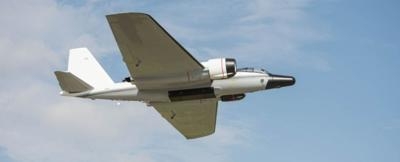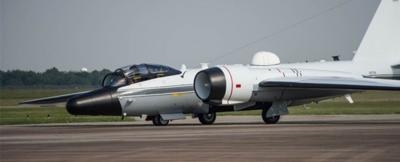Flies At Altitudes Of Up To 70,000 Feet For Research
EAA this week confirmed that NASA will bring a Martin/General Dynamics WB-57F high-altitude aircraft to Oshkosh this year. Based at Ellington Field near NASA’s Johnson Space Center in Houston, TX, the WB-57F operates in NASA’s High Altitude Research Program. The aircraft provides unique, high-altitude (up to 70,000 feet MSL) airborne platforms to United States government agencies and other customers for scientific research, advanced technology development, and testing around the world. This will be the first appearance by a WB-57F at AirVenture.

The WB-57F aircraft are descendents of the B-57B - a license-built version of the English Electric Canberra – that were operated by the Air Force and Air National Guard from the early 1950s-1970s, and RB-57D aircraft operated by the Air Force from the mid-1950s to the mid-1960s.
“The WB-57 shows the brilliance and longevity of the innovation that came from the early jet era,” said Jack Pelton, EAA chairman of the board. “The addition of this aircraft on our main plaza again shows that you’ll discover a collection of aircraft each year at Oshkosh that you’ll see together nowhere else in the world.”
The current variant is derived from the Martin/General Dynamics RB-57 Canberra, a highly specialized strategic reconnaissance aircraft developed by General Dynamics in the 1960s from the Martin B-57 Canberra tactical bomber.
The Air Force bought 21 WB-57F aircraft, which were built by General Dynamics from existing B-57Bs and RB-57Ds. The airplanes’ ability to reach altitudes over 65,000 feet, carry payloads in excess of 4,000 lbs, and its triple spar wings made it a very capable high-altitude platform. Missions included everything from weather reconnaissance for Apollo space launches to sampling radiation in nuclear weapon test plumes.
In the late 1960s and early 1970s the Air Force decided to ground the WB-57F and depend exclusively on the U-2 for high-altitude support. The mission of monitoring nuclear test bans was better done by the WB-57F than the U-2, however. That mission was important enough that three aircraft were given to NASA to keep that capability alive, which were designated N925N, N926NA, and N928NA.

When N925N was retired and put on display at Pima Air & Space Museum in Tucson, Arizona, it that left NASA with two WB-57Fs. Another airframe joined the fleet in 2011 after been taken out of the 309th Aerospace Maintenance and Regeneration Group, (AMARG), better known as the “Bone Yard,” at Davis-Monthan Air Force Base, Arizona. The aircraft, designated N927NA, began as a B-57B, and then was one of 21 aircraft rebuilt as an RB-57F in 1964. As an RB-57F the aircraft had its wingspan increased to 122 feet and the original Wright J65 turbojets were replaced by Pratt & Whitney TF-33 turbofans, doubling both the wingspan and thrust.
N927 had been retired in June 1972 and remained on “celebrity row” at the Bone Yard until May 2011 when it was dismantled and trucked to Sierra Nevada Corporation at Centennial Airport, Colorado. After being refurbished to flying condition it was flown to Ellington AFB in August 2013.
The aircraft had been in storage for over 40 years and made its first flight in 41 years in the summer of 2013, setting a record for the longest an aircraft had sat in the Bone Yard before returning to flying status.
Since 2000, the unique performance capabilities of the WB-57F aircraft and increasing costs associated with the ER-2 program have resulted in NASA allowing multiple customers to use the WB-57Fs for atmospheric and satellite sensor research. The DOD programs have gotten much broader, and N928 (and sometimes N926) have multiple customers asking us to help them develop satellite sensors.
Currently both aircraft are enjoying multiple customers, and all are enjoying the ability to operate on either aircraft. During this time, both aircraft were upgraded with global positioning satellite navigation systems, F-15 main landing gear and brakes, and the gross weight capability of both aircraft was certified from 63,000 pounds to 72,000 pounds. Current ongoing upgrades to the aircraft include installation of the ACES II ejection seat system and installation of an improved, modern autopilot.
Exact arrival is to be determined, but plans are for the WB-57F to be on display for the entire week.
(Images provided by NASA)
 Classic Aero-TV: Active Winglets -- Tamarack Aerospace Partners with Cessna
Classic Aero-TV: Active Winglets -- Tamarack Aerospace Partners with Cessna Aero-News: Quote of the Day (05.03.25)
Aero-News: Quote of the Day (05.03.25) ANN's Daily Aero-Term (05.03.25): Taxi
ANN's Daily Aero-Term (05.03.25): Taxi ANN's Daily Aero-Linx (05.03.25)
ANN's Daily Aero-Linx (05.03.25) Airborne 05.02.25: Joby Crewed Milestone, Diamond Club, Canadian Pilot Insurance
Airborne 05.02.25: Joby Crewed Milestone, Diamond Club, Canadian Pilot Insurance




